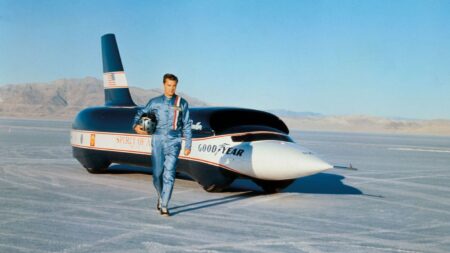
Spirit of America: Sonic I - World's first 600mph car sells for $1.3m
The world's first 600mph car, Spirit of America Sonic I, has been auctioned in a public sale for over $1m
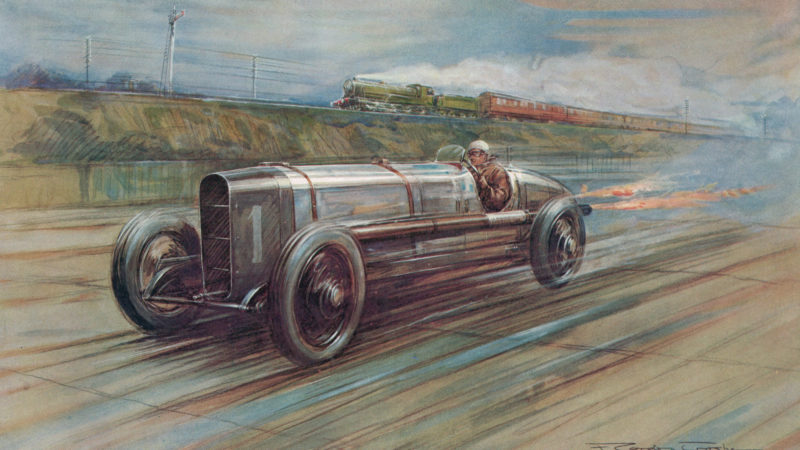
Kenelm Lee Guinness and 350hp Sunbeam pass a steam train at Brooklands in F. Gordon Crosby's painting
A defining moment in land speed history is being celebrated at Brooklands today; 100 years after the final record was set at the circuit.
A crowd of around 1000 are marking the moment that Kenelm Lee Guinness reached an average speed of 133mph in the 350hp Sunbeam on May 17, 1922.
It was the final land speed record set on a closed circuit, with all subsequent benchmarks set on straight courses.
But it was also the start of new era in speed runs: the Sunbeam was the first car to set a record with an aeroplane engine, an 18-litre V12 Manitou, developed for naval seaplanes. Most cars to this day have used aviation power.
“The 350hp Sunbeam was on the railway straight with a steam train above, just as it was in 1922”
The successful attempt, set over a kilometre, also produced an image that would go on to inspire a new generation of car and racing enthusiasts. Frederick Gordon Crosby’s painting of the Sunbeam on the Railway Straight, with flames spitting and wheels ablur while overtaking a racing steam engine, captured the thrill of the moment.
This morning, that picture was recreated as a steam train puffed past the very same car on the very same stretch of the Brooklands track.
“One of the greatest mementos of the day is that Frederick Gordon Crosby painting,” said Allan Winn, vice-president of Brooklands Museum. “Thanks to the cooperation of Network Rail and Steam Dreams, at around half past nine in the morning, we had the 350 horsepower Sunbeam on the railway straight with a steam hauled train above the track, just as it was in 1922.”
On the 17th May 1922, Kenelm Lee Guinness broke the land speed record here at Brooklands driving the Sunbeam 350hp
On the 17th May 2022, we recreated the iconic painting of his record, with his grandson, also named Kenelm Lee Guinness in the driving seat 📸#brooklandsmusuem pic.twitter.com/93xXgfXQcZ
— Brooklands Museum (@BrooklandsMuseu) May 17, 2022
The car was conceived by Sunbeam’s chief engineer and racing team manager, Louis Coatalen, and was constructed during 1919.
Motor Sport was founded two years after the 1922 record attempt, when the Sunbeam was still going strong. In our fourth issue, dated October 1924, we reported on Malcolm Campbell stretching the record to 146.16mph over a kilometre at Pendine in the rebuilt car, painted in his trademark blue. The following year, he became the first person to break the 150mph mark in a mile-long run.
“One has only to sit behind the big engine and let the car go on a stretch of good sand to feel as if some supernatural force were at work,” wrote Campbell in our December 1925 issue. “A force which, though controlled by the hand of man, is so terrific as to inspire awe.”
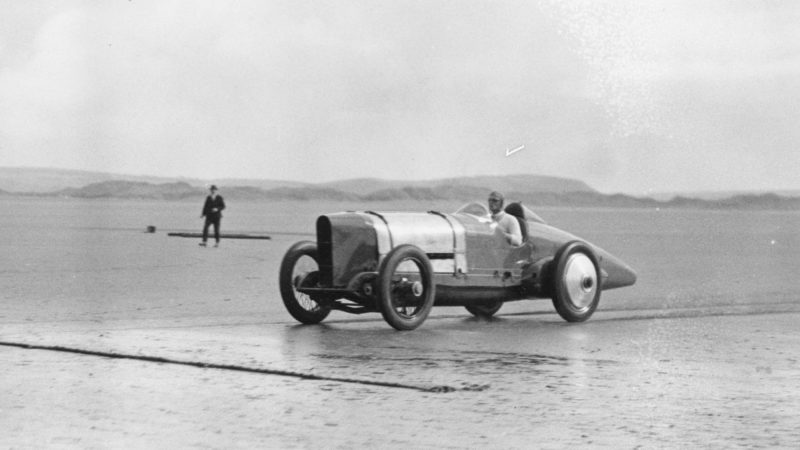
Malcolm Campbell at Pendine in 1924, where he set a new land speed record in the 350hp Sunbeam
Topical Press Agency/Getty Images
Although stopping preoccupied much of Campbell’s thoughts, it was the engine that proved the real innovation.
“It was the first land speed record car that effectively had an aeroplane engine,” Winn said. “That was the thing with record breaking in the 1920s, there were always surplus aircraft engines left over from the First World War.
“They were powerful but crucially, they were light, too. That’s what made the Sunbeam an effective motor car, because back in the day to have 350 horsepower, easily available in a lightweight engine, was really quite fantastic.”
As well as the 1922 car, Brooklands is hosting several other early land speed record pioneers, with demonstrations on the start-finish straight.
“We have several cars that were aimed at setting land speed records,” said Winn. “We have the 1905, 200 horsepower Darracq coming, we have the 1924 Délage V12 that broke the land speed record in France, we have various other record vehicles of their year, and then we have lots of other Sunbeam race cars like the 1916 Indianapolis car.”
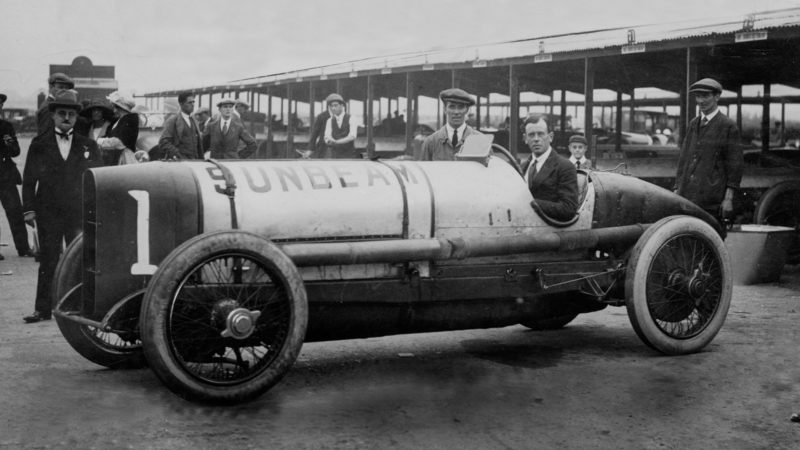
Kenelm Lee Guinness in the 350hp Sunbeam at Brooklands in 1920
National Motor Museum/Getty Images
Among the spectators are descendants of the driver, Lee Guinness who, alongside his racing career, is famous for inventing the KLG spark plug, as well as being part of the Guinness brewing family.
A Cambridge University graduate, Guinness joined Sunbeam as an official driver in 1913 and that started an eleven-year stint with the team.
However, that all came to an abrupt and sad end following a crash at the 1924 San Sebastian Grand Prix, which killed his riding mechanic instantaneously, as well as causing serious head injuries to Guinness. He died by suicide 13 years later.
“We have several generations of the Guinness family here,” said Winn. “Grandchildren of both Algernon [Guinness, his brother] and Kenelm, as well as his last surviving daughter. So we’ve got a whole string of the Guinness family in attendance for what is going to be the most fantastic reunion.”

The world's first 600mph car, Spirit of America Sonic I, has been auctioned in a public sale for over $1m
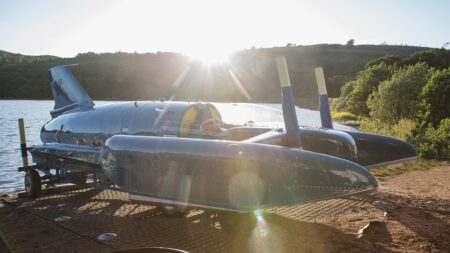
Donald Campbell's water speed record craft, Bluebird K7, will go on display at Coniston after the end of a bitter legal battle. The man who led its restoration and recovery says it will be left a "dead machine"
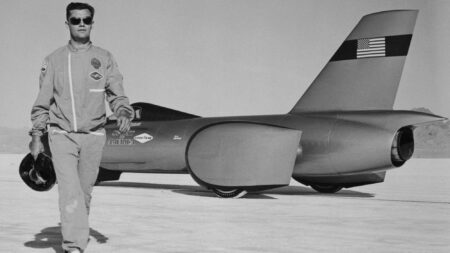
In a life dedicated to speed, Craig Breedlove was the first person to hold land speed records at 400mph, 500mph and 600mph, survived a 675mph crash, and never stopped dreaming about the next attempt
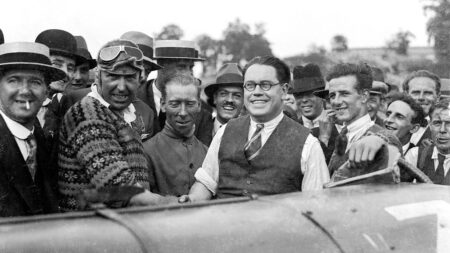
The irrepressible Ernest Eldridge was an unstoppable force in matters of velocity, becoming the last man to set a land speed record on an open road in 1924